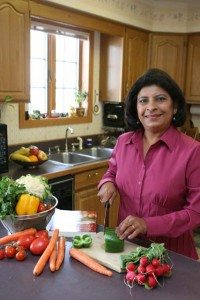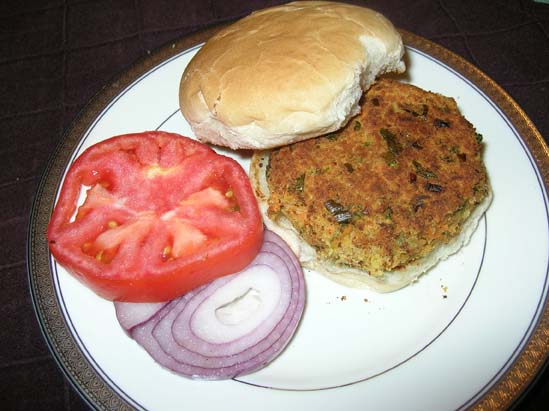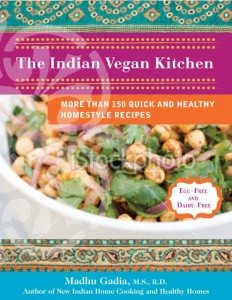When Oprah features a vegan recipe from Madhu Gadia in her magazine, you know it’s hot! The good news is that if you happen to be vegan, can’t eat eggs or dairy, you don’t have to be exiled to a Siberia of bland vegetables anymore. You can be vegan and still eat very well. In fact, there are some Indian vegan super foods that can light up the menu and give you all the nutrition and flavor that you need. So what are these magic foods?
In her new book, ‘The Indian Vegan Kitchen’ dietician Madhu Gadia says, “Superfoods are packed with vitamins, minerals and phytonutrients. The Indian diet emphasizes nutrient-dense foods that have extraordinary health promoting qualities.” Her power list is headed by almonds, that all-time favorite of Indian mothers ( I recall my mother giving me handfuls of almonds as I studied late into the night during exam time). Gadia says that eating one ounce of almonds each day may lower LDL (bad) cholesterol levels and reduce the risk of heart disease.
The other superfoods she suggests are canola oil, cauliflower, dal (beans), ginger, spinach, tea, whole wheat flour, and turmeric. You’ll be happy to know that tea and mangoes – major addictions with most Indians – are also on this power list!
While oil has become almost a four-letter word for the calorie conscious, Gadia says Canola oil is one of the healthiest and most versatile cooking oils, with the lowest saturated fat content of any oil commonly used in the US.
Cauliflower, which is used so often in Indian meals, is high in fiber, folate, Vitamin C and other nutrients, and also contains phytochemicals that may help prevent cancer. Spinach has iron, calcium and folate but is also rich in lutein, a carotenoid that helps in age-related vision problems.
Good old dal is also a power player and Gadia points out that dried beans contain flavonoids, which can protect against heart disease and certain cancers. Ginger and turmeric are the stars of Indian cuisine for all their wonderful properties. Ginger contains gingerol, a free radical that acts as a antioxidant, and helps in digestion and may even help prevent the common cold while turmeric’s qualities are now being recognized in the west.
It is good to know that both mango and tea not only taste good but are good for you. “Regular tea consumption not only helps to prevent cancer, heart disease and other illnesses but also reduces the risk of stroke, obesity, arthritis, and diabetes,” says Gadia. So drink away!
As for mangoes, they have a great resume too, chock full of nutrients and phytochemicals. Get some of these wonder foods into your vegan diet, and you’re all set.
In ‘The Indian Vegan Kitchen’ Gadia shows how to plan healthful vegan meals, suggests menus and also gives vegetarian recipes and resources. I tried one of the recipes – Cabbage Mixed Vegetables (Bund Gobhi Milli Subji), since I had a whole head of cabbage in the fridge. It took 10 minutes to cook, used only one tablespoon of oil and tasted simple and home-style, something comforting like the family cook in Delhi might have whipped up.
ALL THAT YOU WANTED TO KNOW ABOUT A VEGAN DIET
– BUT WERE AFRAID TO ASK
An interview with Madhu Gadia, M.S., R.D, who is a registered dietician and the author of ‘The Indian Vegan Kitchen’ and ‘New Indian Home Cooking.’ Her website is www.cuisineofindia.com
Q: As a dietician, what do you feel is the special value of a vegan meal? Is it still possible to get all the nutrition that you need every day with such a diet?
Numerous fears and myths surround vegan diets and its nutritional adequacy, but as with other diet, if it’s planned properly it can meet your nutritional needs. The main concerns are to get adequate calcium, vitamin D, vitamin B12, iron, and zinc. It is important to recognize that, as with a non-vegetarian diet, including a variety of foods is necessary to get all the nutrients you need.
One of the primary reason people choose all plant-based diet is for its health benefits and reducing risk of heart disease and cancer. There is a lot of research pointing to the benefits of phytochemicals and antioxidants, and many of these vital nutrients are only found in plant sources. Antioxidants have been found to be helpful in lowering cholesterol levels, balancing hormones, and eliminating toxins. Whether you choose to be vegan or lacto-vegetarian (majority of vegetarian Indians are lacto-vegetarian – which is vegan plus dairy) or lacto-ovo-vegetarian (vegan+dairy+eggs), it is important to plan your meals to include variety of nutrients. Many healthy experts are recommending that people eat 1 to 3 vegetarian meals a day.

Q. What about dishes which use a lot of yogurt such as tandoori cooking. How can those be replicated without the dairy products?
Tandoori dishes are primarily meat based, and yogurt is a great way to tenderize meat.
On the other hand, dishes like Rajmah, Kofte, and Korma dishes use yogurt or cream for thickening, creamy consistency, and taste. In ‘The Indian Vegan Kitchen’, I have used almonds and cashews to give the same taste and texture to these types of dishes with even a better flavor.
Q: You write that you equate Indian deep-fat frying to baking. How is this possible? Don’t we use 2-3 cups of oil for deep frying?
Yes, but all of the oil is not absorbed when frying. If you compare apples to apples, that is, look at baked cookies which use 1 cup of butter for 2 1/2 cups of flour, and look at Sugar Coated Pastry Strips (Shakker-Paree) they have about the same grams of fat per serving. Another example is poori vs croissants, both high in fat or even baking powder biscuits–and you put butter on top of it! Or compare samosa to croissant type pastry- the samosas actually may have less fat. Of course, it is important to limit how often and how much you eat of fried or baked goods.
Q: What is your nutritional advice for diabetics who are vegetarian or vegan?
The cause of diabetes appears to be increased body weight, increased intake of processed foods, and sedentary lifestyle. Vegan or vegetarian diet alone cannot prevent diabetes. People with type 1 or type 2 diabetes should consult their physician and follow the recommendations to manage their blood glucose levels. They should also discuss and plan their vegan diet with a registered dietitian.
:Studies using low-fat vegan, vegetarian, or almost-vegetarian diets for treatment of cardiovascular disease have shown marked improvements in blood glucose control and reduced requirements for hypoglycemic medications with the diet. But most of these studies also included lifestyle changes such as increased exercise, and weight reduction.
The Indian Vegan Kitchen Recipes
Madhu Gadia shares three recipes which are easy and fun and great for the casual quick dining which seems to have become a part of our everyday lives. These dishes can be transported to work quite conveniently, rather than splurging on takeaway foods.
Buckwheat-Zucchini Pancakes
(Kuttu-Cheele)
GF, LF (Gluten Free, Low Fat)
Prep Time: 5 Minutes Cook Time: 15 Minutes
Makes 6 servings. Serving size – 2 Cheele.
Indian cooks use buckwheat primarily when they want to avoid grains (such as during fasts); buckwheat dishes are typically wheat free and gluten free. These cheele are soft and taste best when eaten fresh. I like them with a sweet chutney, like tamarind or mango chutney, or pour some maple syrup over them, if desired.
1 cup buckwheat flour (kuttu atta)
7/8 cup water
3/4 teaspoon salt
1/2 teaspoon ajwain (optional)
2 teaspoons sugar
1/2 teaspoon cayenne pepper, to taste
1/2 cup boiled potatoes, finely mashed
1 cup grated zucchini
2 tablespoons canola oil
- In a medium bowl mix buckwheat, water, salt, ajwain, sugar, and cayenne pepper. Stir in mashed potatoes and grated zucchini. Let stand for 5 to 10 minutes.
- Heat iron griddle on medium high heat or use an electric griddle heated to 400ºF. Lightly oil the griddle and wipe off the oil. Add about a 1/4 cup of batter on the hot griddle and spread to about 3-inch pancakes. Add small amounts of oil on all sides and top of the pancake. (You can cook several pancakes at time based on size of your griddle.)
- Cook until edges appear brown and the pancake comes off easily. Turn the pancake over and cook for another one minute.
- Serve hot with chutney of choice.
Nutrition Information Per Serving: Calories: 122; Total Fat: 5 g (Saturated Fat: 0.5 g); Carbohydrate: 17 g; Protein: 3 g; Fiber: 2 g; Sodium: 326 mg

Bean Burgers
Dal-Vada Burger
Prep Time: 10 Minutes Cook Time: 15 Minutes
Makes 4 servings. Serving size – 1 sandwich
Sandwiches are an easy way to enjoy a meal without a plate. Although not traditional Indian food, sandwiches are enjoyed by everyone today. If you like veggie burgers made with beans, you’ll love these. This is my version of a bean burger that is easy to make and fun to eat.
1 can (16-ounces) Chickpeas
1/4 cup scallions with greens, finely chopped
1/2 cup carrots, peeled and grated
2 teaspoons ginger, grated
1/2 teaspoon ground cumin
1/2 teaspoon salt
2 teaspoons green chilies, finely chopped, to taste
1/4 teaspoon cayenne pepper, to taste
1 tablespoon lemon juice
2 tablespoons cilantro, finely chopped
2 tablespoons bread crumbs
2 tablespoons vegetable oil
4 whole wheat hamburger buns
4 tomato slices, garnish
4 onion slices, garnish
Cilantro chutney (optional)
Tomato ketchup (optional)
- Drain and rinse the canned chickpeas. In a food processor grind the beans until smooth.
- In a medium mixing bowl add ground beans, scallions, carrots, ginger, salt, green chilies, cayenne pepper, lemon juice, cilantro, and bread crumbs. Mix well.
- Oil your palms and make 4 patties. Set aside.
- Heat 2 tablespoons oil on medium high heat in a large skillet. Add patties and grill for 5 to 7 minutes on each side until golden brown. (If needed, add a little more oil to help brown the patties.)
- In the meantime lightly oil the buns and grill in a fry pan or a griddle until light brown.
- Place a patty on the bottom half of bun, top with tomatoes, onions, cilantro chutney, and tomato ketchup, as desired. (Note: You can make the patties up to one day ahead and grill them when ready to eat. For a grilling party, fully prepare the patties and reheat on grill on aluminum foil.)
Nutrition Information per serving: Calories: 311; Total Fat: 11 g (Saturated Fat: 1 g); Carbohydrate: 45 g; Protein 11 g, Fiber: 10 g, Sodium: 679 g
Neembu Rasam
Lemon-Pepper Soup
Prep Time: 5_____Minutes Cook Time: 30 Minutes
Makes 8 servings. Serving size 1 cup
Rasam is a South Indian dish. It is a broth like soup that is typically made with pigeon peas/toor dal as the base. There are numerous variations, but rasams are always flavorful and often quite spicy. I fell in love with this version the first time I tried it at my friend Simi’s house. It was winter and I had a cold. The rasam was piping hot and spicy, it hit the spot as well as cleared my sinuses. Adjust the black pepper to your taste and enjoy this rasam by the cupful.
1/2 cup (split, hulled) toor dal/pigeon peas
6 cups water, divided
3/4 teaspoon salt
1/4 teaspoon turmeric
1/2 teaspoon black pepper, to taste
1 to 2 teaspoons green chilies, finely chopped, to taste
4 tablespoons lemon juice
1 tablespoon cilantro, chopped
Seasoning (chaunk):
1 1/2 tablespoons vegetable oil
1/2 teaspoon mustard seeds
1/2 teaspoon cumin seeds
1/4 teaspoon asafetida powder (optional)
1 to 2 dried red chilies
6 to 8 curry leaves
- Wash toor dal in 3 to 4 changes of water and drain.
- (Cook toor dal in a pressure cooker or in a pan. To cook in pan, see Note below.)
In a medium pressure cooker add washed toor dal, 2 cups water, salt, and turmeric. Cover with the lid and put the pressure weight in place. Once pressure develops, reduce heat and cook under pressure for 5 minutes. Cool the cooker until the pressure is removed. Open the lid carefully. Using a wire whisk blend the dal until smooth.
- Add the remaining 3 cups water, black pepper, and green chilies. Bring to boil. Reduce heat and simmer for 10 minutes.
- Prepare seasoning: In a small fry pan heat the oil on medium high. Add the mustard seeds, cover with lid, cook for a few seconds, until mustard seeds stop popping. Add cumin seeds, asafetida, and whole dried red chili, cook for a few seconds, until cumin seeds turn brown. Remove from heat and add curry leaves, cook for a few seconds.
- Add seasoning to the rasam. Remove from heat.
- Add lemon juice and chopped cilantro. Serve rasam hot in a soup bowl or a cup.
Note: To cook in a skillet. You need to soak the dal after washing it as in step 1. Soak the dal for 2 hours or longer. Combine drained dal, 4 cups of water, salt, and turmeric. Bring dal to boil, reduce heat and simmer for 25 to 30 minutes, until the dal is very soft. Follow steps 3 and 4 to finish the rasam. (You will need up to 6 or 7 cups of water when preparing in a pan, as it takes longer to cook and more water evaporates.)
Nutrition Information per serving: Calories: 67; Total Fat: 3 g (Saturated Fat: 0 g); Carbohydrate: 8 g; Protein: 3 g; Fiber: 2 g; Sodium: 220 mg


1 Comment
Please research the dangers of canola oil – It is possibly the most dangerous food on the planet
Better choices are cold pressed organic coconut oil and grape seed oil. Also rice bran oil
,